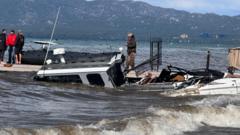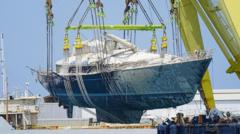In a troubling turn of events, the U.S.S. Harry S. Truman collided with the Panamanian bulk carrier Besiktas-M near Port Said, Egypt, while on its operational mission in the Mediterranean. Fortunately, no injuries or significant damage were reported on either vessel.
U.S. Navy Carrier Involved in Collision Near Egypt

U.S. Navy Carrier Involved in Collision Near Egypt
The U.S.S. Harry S. Truman collides with a merchant vessel while on deployment in the Mediterranean Sea.
The U.S.S. Harry S. Truman, a Nimitz-class aircraft carrier deployed under U.S. Central Command since mid-December, was involved in a collision in the Mediterranean Sea on Wednesday night, as confirmed by Navy officials. The incident occurred shortly before midnight, stirring concerns about maritime safety.
The carrier has been conducting operations in the Red Sea, actively launching airstrikes against Houthi militias in Yemen that have targeted civilian and Israeli-associated shipping. Fortunately, the Navy reported that there were no injuries or damage to the Truman, with its onboard nuclear reactors remaining stable and unaffected. An official statement indicated that the collision is currently under investigation.
Tracking data from Vessel Tracker confirmed that the merchant vessel involved, the Besiktas-M, was a bulk carrier built in 2003 and registered under the Panamanian flag. It was en route from Aqaba, Jordan to Constanta, Romania when the incident occurred. Fortunately, the crew members aboard the Besiktas-M also reported no injuries.
This incident marks a departure from the U.S. Navy’s recent record of safety regarding commercial vessel interactions, particularly after a series of near-fatal collisions in 2017 that resulted in the deaths of 17 sailors and subsequent investigations. Those accidents were deemed preventable and sparked a major reassessment of naval operations, leading to a stand-down of all Navy ships and changes in command. As authorities look into this recent incident, the focus remains on ensuring the safety and efficiency of naval engagements with civilian maritime traffic in the future.





















